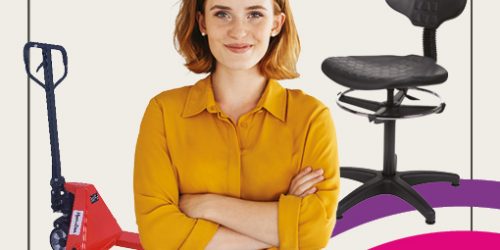The Manutan brand: products with an uncompromising quality assurance process

Since 2016, the Manutan brand has been providing companies and local authorities with everyday products. As these materials, resources, and equipment are intended to be used on a daily basis by employees in their work, quality is key. Indeed, a reliable and effective product directly contributes to the health, safety, and well-being of end-users.
To guarantee a high level of quality within the Manutan brand, a strict process is applied to all products. This allows us to offer a policy that remains unique on the market: a 10-year warranty on all products and a 3-year warranty on consumables. Thibault Brauge, Supplier Quality Assurance Manager at the Manutan Group, explains how quality management is an integral part of the Manutan brand listing process.
Could you please tell us a little about your background?
Thibault Brauge: I have more than 20 years of experience in product quality. Before joining the Manutan group, I worked in the Business-to-Customer retail sector and for international purchasing groups. In particular, I spent a lot of time in China where I ensured the quality management of the products manufactured there. It was a great challenge!
With a proven method, training, and an international network of service providers, I now use my skills to assist Manutan Group customers. As Supplier Quality Assurance Manager, I am responsible for the quality of all Manutan brand products, from the office to the warehouse, including industrial supplies and tools, packaging, safety, hygiene, outdoor space, and, finally, catering.
How is the quality of Manutan brand products monitored?
TB: Manutan has the same responsibility as a manufacturer. To ensure a high level of quality, I’m involved throughout the product life cycle:
- Upstream, by analysing the products before any listing takes place;
- Downstream, based on after-sales service data (breakage rate, overall satisfaction, etc.).
In order to adopt a true continuous improvement approach, the upstream stage is essential. Once we have identified and mapped the supplier and the product we are planning to list, we:
- Determine the product target, i.e. a product that serves as our quality benchmark;
- Collect the product sample and documentation (regulatory documentation, instruction manual, certifications, and labels, etc.);
- Analyse the product through internal and external tests, as well as the documentation package.
After defining these elements, I write a full report on the evaluated product. This is then reviewed in a committee with procurement, product managers, the Manutan brand manager, and myself. Together, we decide if the product is suitable for the Manutan brand standards and if we can eventually include it in our offer.
In summary, my work is divided into several tasks, ranging from test management to product management (from entering to exiting our premises), to ensure the quality chain is effectively monitored.
What do the internal product tests involve?
TB: Internally, the product testing is carried out by me. I do this on a case-by-case basis depending on the product and its characteristics. This means I devise new tests for each product reference and compare my sample with the previously selected target product.
This step allows you to check basic criteria:
- Cleanliness: is the product clean? Are the finishes neat? Are there any marks left by the mold on the plastic parts? Is the packaging well put together?
- Assembly: is the product easy to assemble? Is the final result satisfactory, from an aesthetic and functional point of view?
- Sturdiness: can my product withstand heavy loads or impacts?
- Safety: is the health and safety of the user ensured throughout the life cycle of the product?
The key is to put yourself in the user’s shoes. With my equipment, I try to reproduce all types of use and I control the composition of the product down to the smallest detail. For example, for an office, I can use weights and a hammer to simulate the installation of heavy products and even a few knocks that can easily happen in everyday life.
Recently, for a step stool, I even went so far as to cut the product in half to check the materials inside the pads and figure out how the feet were attached! For such a product, it is essential to ensure stability and strength.
Moreover, all Manutan products, including tools, are FEVAD certified, with dual HQE (High Quality Environmental standard), ISO 9001 and Ecovadis certification.
In which cases do you use external laboratories?
TB: When I feel the need to carry out additional tests or when I lack the technical means to evaluate a product, I call on my network of service providers. Depending on the nature of the test required (mechanical, electrical, etc.), I contact a specific laboratory and ask them to recommend test protocols, then implement the suggested procedure.
The latest example concerned an electrical office. Our challenge was to ensure that the electrical system would continue to function for 10 years, as guaranteed by our warranty. After carrying out the basic tests internally, I commissioned a service provider to test the life of the product under real-life conditions. We placed the product in an oven at 45°C, with a certain humidity level. We then simulated 10 years of use, in concentrated cycles, with a weight of about sixty kilos on the table!
It is thanks to this uncompromising quality control process, which combines rigorous supplier selection and comprehensive product analysis, that we can guarantee Manutan brand products for 10 years.
You can view the full range of Manutan brand products here



